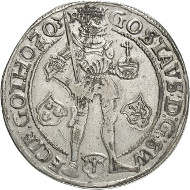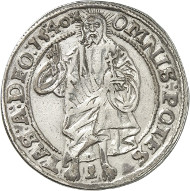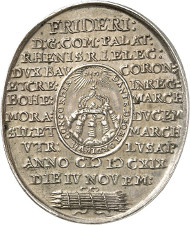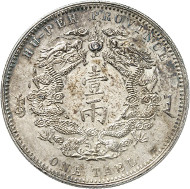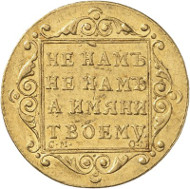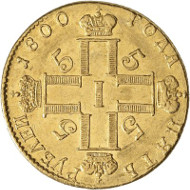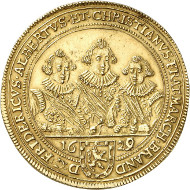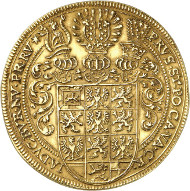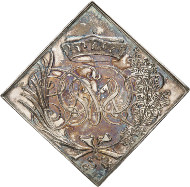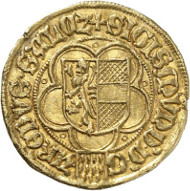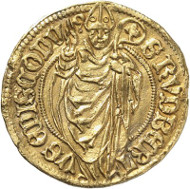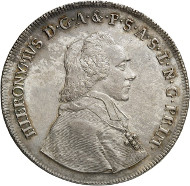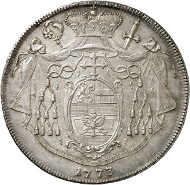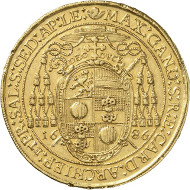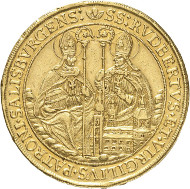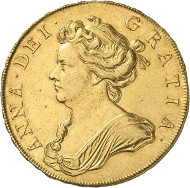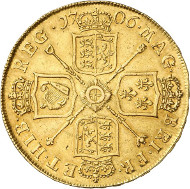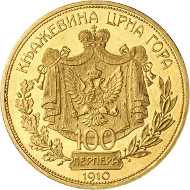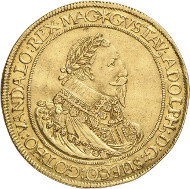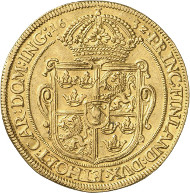26-09-2015 – 30-09-2015
Auction 266-269
Highest-grossing auction week in the history of Künker
Six auctions conducted over the course of six days is remarkable in itself, but a turnover of 13.8 million euros achieved over the course of only six days truly marks a new record. With the final result Auction House Künker happily records the highest-grossing auction week in the history of the company.
Not only the large number of special collections accounted for this impressive result, but also the broad range of world and ancient coins as well as orders and decorations. With estimates starting at 20 euros, many collectors know that at Künker, they will find the right coin.
Auction 266: Coins and Medals from Medieval and Modern Times / Russian Coins and Medals
Auction 266 placed a special focus on Sweden, including its foreign mintages. During the Thirty Year War, Sweden laid siege on many German cities. Here, an undated Würzburg reichsthaler from the years 1633/34 depicting a portrait of the Swedish Lord Chancellor Axel Oxenstierna can surly be summarized under Sweden.
Lot 1947: SWEDEN. Gustav Vasa, 1521-1560. 1540 daler, Västeras. 2nd specimen known to be in private possession. Good very fine. Estimate: 50,000,- euros. Hammer price: 75,000,- euros.
It also was the Swedish coinage where the real sensations were happening: The second known specimen of a 1540 salvatordaler of Gustav Vasa rose from its estimate of 50,000 euros to 75,000 euros. Estimated at 25,000 euros each, two pieces obtained as much as 42,000 euros: a daler of Sigismund, struck in Stockholm in 1594, and a 1633 daler of the underage queen Christina. Yielding 80,000 euros, the rarest item of the Swedish section was a thick double 1649 reichsthaler of afore mentioned Christina. It formerly belonged to the Bonde Collection and obtained the very good result of 80.000 euros although it did not quite match the pre-sale estimate of 100,000 euros.
Lot 1706: HRE. Frederick Elector Palatine, 1619-1621. Struck oval-shaped silver medal, 1619, by Chr. Maler on the coronation as King of Bohemia. Extremely rare. Extremely fine to FDC. Estimate: 12,500,- euros. Hammer price: 21,000,- euros.
Other spectacular individual items among the European coins changed hands as well: a magnificent 1619 silver medal on the Winter King Frederick, Elector Palatine (12,500 euros / 21,000 euros), and an extremely rare 1861 pattern, in the best grade possible, of the French 5 francs coins minted in Paris and Strasbourg between 1861 and 1870 (10,000 euros / 19,000 euros).
Lot 2129: CHINA. Hupeh Province. Liang (tael) year 30 (1904). Very rare. Extremely fine. Estimate: 3,000,- euros. Hammer price: 11,000,- euros.
The fact that China may always spring a surprise was proven by a very rare and extremely fine 1904 liang, from the Hupeh Province. It obtained an incredible hammer price of 11,000 euros (estimate: 3,000 euros).
Russian coins and medals concluded Auction 266 and this department came up with many surprises.
Lot 2285: RUSSIA. Paul I, 1796-1801. 5 roubel 1800, St. Petersburg. Rare. Extremely fine. Estimate: 4,000,- euros. Hammer price: 40,000,- euros.
The biggest was a rare and extremely fine 5 roubel piece of Paul I. Unspectacular at first glance, this item, minted in St. Petersburg in 1800, nevertheless obtained 40,000 euros. That’s ten times its original estimate of 4,000 euros. Another numismatic item reached “just” four times its appraisal: a 1748 ducat of Tsarina Elizabeth struck in the Moscow Red Mint. The bidding started at 10,000 euros but the ducat was sold for a hammer price of 44,000 euros. Last but not least, the buyer of a Georgian 1230 dirhem of the Bagratids gladly paid six times the estimate. The coin commemorates the recapture of Tiflis in the very same year (estimate: 250 euros / hammer price: 1,600 euros).
Auction 267: Brandenburg in Franconia and the Franconian Imperial Circle – The Roland Grüber Collection
Certainly a lot of collectors wondered about how many potential buyers could be interested in the “Roland Grüber Collection”. The material from Brandenburg in Franconia and the Franconian Imperial Circle that was to cross the auction block consisted of more than 2,300 lots – wouldn’t this enormous offer of numismatic items make the prices plummet?
Lot 4209: BRANDENBURG-ANSBACH. Frederick, Albrecht and Christian, 1625-1634. 5 ducats 1629, Nuremberg. Unique. Extremely fine. Estimate: 20,000,- euros. Hammer price: 38,000,- euros.
But, as a matter of fact, it did not, and what happened was quite the opposite. This sale once again vouched for the fact that individual items, belonging to an expertly assembled collection, actually obtain better prices. Let us single out one example: a small series of pfennigs issued under Margrave Frederick V between 1361 and 1397. Estimated at sums ranging between 20 and 30 euros, the seemingly unspectacular specimens attained considerably better results, reaching as high as 130, 140, 150, 180, and even 190 euros.
This trend continued and the total hammer price for the “Roland Gruber Collection” added up to 2 million euros, 50% more than the total pre-sale estimate. Naturally, a few spectacular individual items contributed to this magnificent result.
Lot 3626: SAXONY. John George II, 1656-1680. Triple reichsthalerklippe 1676, Dresden, on the bird shooting competition in Dresden on July 23, where the electoral prince (later to be Prince Elector John George III) fired the decisive shot, thus making his mother Magdalena Sibylla become queen of shooters. Ex Peus Auction 364 (2000), 1671. Very rare. Extremely fine to FDC. Estimate: 20,000,- euros. Hammer price: 38,000 euros.
Let us present to you some selected examples: Two lots share the title of the most expensive coin of the Grüber Collection: a triple 1676 reichsthalerklippe on the bird shooting competition in Dresden on July 23 of the same year and a quintuple ducat of Frederick, Albrecht, and Christian of Brandenburg-Ansbach, minted in Nuremberg in 1629 (estimate: je 20,000 euros / hammer price each: 38,000 euros).
Lot 3643: BRANDENBURG-BAYREUTH. Christian Ernest, 1655-1712. Reichsthaler 1683, Bayreuth. Ex Wilmersdörffer Collection, Helbing Nachf. Auction 48 (1925), 658. Extremely rare. Extremely fine. Estimate: 10,000,- euros. Hammer price: 29,000,- euros.
An extremely rare and extremely fine 1683 reichsthaler of Christian Ernest of Brandenburg-Bayreuth obtained 29,000 euros (estimate: 10,000 euros), while an equally rare, nearly extremely fine 1746 pistole of Frederick of Brandenburg-Bayreuth achieved 24,000 euros (estimate: 10,000 euros). Lastly the auction sale’s cover piece, a golden achievement medal of 10 ducats of Christian Frederick Charles Alexander of Brandenburg-Ansbach, estimated at 10,000 euros, was auctioned off for 15,000 euros.
Auction 268: Coins and Medals of the Archbishopric of Salzburg – The Numitor Collection
The numismatic material offered in Auction 268 comprised exceptional gold and silver coins from Salzburg.
Lot 5502: SALZBURG. Sigismund of Volkersdorf, 1452-1461. Gold gulden n. d., Salzburg. 2nd specimen known to exist. Extremely fine. Estimate: 75,000,- euros. Hammer price: 85,000,- euros.
The Numitor Collection, for example, included the 2nd known specimen of a gold gulden of Sigismund of Volkersdorf. Exhibiting the first depiction of Saint Rupert on Salzburg coinage we know of, this was an item of great numismatic interest. Estimated at 75,000 euros, this specimen’s hammer price, however, was nothing less than 85,000 euros, making this early coin one of the two most expensive items of the entire auction sale.
Lot 5727: SALZBURG. Hieronymus of Colloredo, 1772-1803. 1790 löwenthaler. Ex Leu Auction 75 (1999), 1100. Extremely rare. Nearly FDC. Estimate: 75,000,- euros. Hammer price: 85,000,- euros.
The second coin which rose from its estimate of 75,000 euros to an impressive final bid of 85,000 euros was one of the last coins produced in Salzburg. Because of a Bavarian intervention, most specimen of this extremely rare 1790 löwenthaler of Hieronymus of Colloredo were melted down, leaving only a few in circulation.
Altogether, not every single lot of the Numitor Collection reached a price that matched its – generally high – estimate: A case in point is a 10 ducat specimen of the tower coinage of Wolf Dietrich of Raitenau. Estimated with the highest appraisal of all at 100,000 euros, it was auctioned off for 80,000 euros. Nevertheless, remarkable results were achieved anyway. Those were mainly coins, which were not only highly appealing to the eye but also of great historical and numismatic interest.
Lot 5639: SALZBURG. Max Gandolph of Küenburg, 1668-1687. 10 ducats 1686, on the ordination to cardinalhood. Unique. Extremely fine. Estimate: 75,000,- euros. Hammer price: 80,000,- euros.
To name just two examples: a unique 1561 4 ducat piece of John Jacob Khuen of Belasi (estimate: 50,000 euros / hammer price: 55,000 euros), and a unique 1686 10 ducat piece of Max Gandolph of Küenburg on the ordination to cardinalhood (estimate: 75,000 euros / hammer price: 80,000 euros).
Auction 269: Gold Coins / German Coins after 1871
Auction 269 featured gold coins from all around the world. By the time the sale was concluded, it had once again become clear that among coin collectors, gold is currently in high regards.
We would like to highlight the section of British coins featuring 104 lots. Obtaining a total hammer price of more than 450,000 euros, they realized more than 2.5 times their pre-sale estimates.
Lot 6192: GREAT BRITAIN. Anne, 1702-1714. 5 guineas 1706, London. Vogel Coll., ex Künker Auction 230 (2013), 6656. Very rare. Extremely fine. Estimate: 20,000,- euros. Hammer price: 60,000,- euros.
The 5 guinea pieces, which at the moment are quite popular, significantly contributed to this noteworthy result. Almost every time a 5 guinea piece crossed the auction block the hammer fell at a price in the five-digit region: a 1688 5 guinea pieces (estimate: 12,500 euros) and another one from 1706 (estimate: 20,000 euros) brought 60,000 euros each.
Not 5 guineas but 5 pounds, dating from 1826 and of which only 150 specimens were struck, brought 55,000 euros. More than once rarity was a decisive criterion as proven by a 1893 2 pound piece of Queen Victoria of which only 773 specimens were minted. Realizing 14,000 euros, this coin by far exceeded its pre-sale estimate of 2,500 euros.
Lot 6415: MONTENEGRO. Nicholas I, 1860-1918. 100 perpera 1910, Vienna. Only 300 specimens struck. Extremely fine / extremely fine to FDC (Prooflike). Estimate: 12,500,- euros. Hammer price: 22,000,- euros.
As witnessed, rarity becomes more and more important, but only in combination with superb grades. Estimated at 12,500 euros each, two types of the 1910 100 perpera, minted in Vienna by Nicholas I of Montenegro almost doubled their prices. One achieved 20,000 euros and the other 22,000 euros (Fb. 1, only 300 specimens struck).
Lot 6914: GERMANY. Nuremberg. 6 ducats 1632, minted under Swedish occupation by Gustavus II Adolphus. Oldenburg Coll., ex Bukowski Auction 113 (1898), 1396. Extremely rare. Very fine to extremely fine. Estimate: 50,000,- euros. Hammer price: 80,000,- euros.
Looking at the most expensive coin of this auction session, we are returning to Sweden, or rather almost. The 1632 sextuple ducat from the city of Nuremberg, struck under Swedish occupation, left its estimate of 50,000 euros soon behind and was auctioned off for 80,000 euros.
Please find all results online here.





